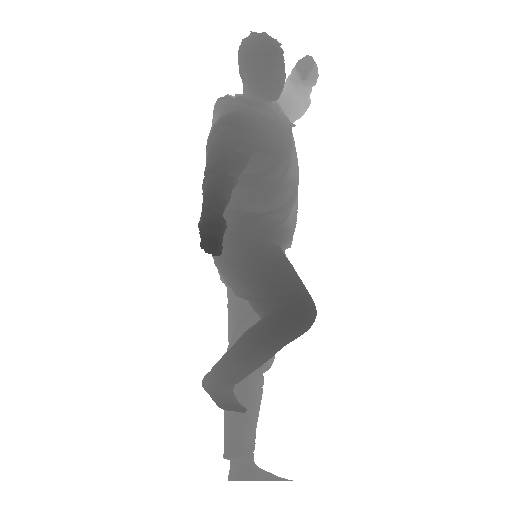ICON: Implicit Clothed humans Obtained from Normals
Yuliang Xiu · Jinlong Yang · Dimitrios Tzionas · Michael J. Black
CVPR 2022
News
🚩
- [2022/04/26] HybrIK (SMPL) is supported as optional HPS by Jiefeng Li.
- [2022/03/05] PIXIE (SMPL-X), PARE (SMPL), PyMAF (SMPL) are all supported as optional HPS.
- [2022/02/07]
is ready to use.
Table of Contents
Who needs ICON?
- Given an RGB image, you could get:
- image (png): segmentation, normal images (body + cloth), overlap result (rgb + normal)
- mesh (obj): SMPL-(X) body, reconstructed clothed human
- video (mp4): self-rotated clothed human
| ICON's intermediate results |
| ICON's normal prediction + reconstructed mesh (w/o & w/ smooth) |
- If you want to create a realistic and animatable 3D clothed avatar direclty from video / sequential images
- fully-textured with per-vertex color
- can be animated by SMPL pose parameters
- natural pose-dependent clothing deformation
| 3D Clothed Avatar, created from 400+ images using ICON+SCANimate, animated by AIST++ |
TODO
- testing code and pretrained models (*self-implemented version)
- ICON (w/ & w/o global encoder, w/ PyMAF/HybrIK/PIXIE/PARE as HPS)
- PIFu* (RGB image + predicted normal map as input)
- PaMIR* (RGB image + predicted normal map as input, w/ PyMAF/PARE as HPS)
- colab notebook
- dataset processing pipeline
- training and evaluation codes
- Video-to-Avatar module
Installation
Please follow the Installation Instruction to setup all the required packages, extra data, and models.
Dataset Preprocess
Please follow the Data Preprocess Instruction to generate the train/val/test dataset from raw scans (THuman2.0).
Demo
cd ICON/apps
# PIFu* (*: re-implementation)
python infer.py -cfg ../configs/pifu.yaml -gpu 0 -in_dir ../examples -out_dir ../results
# PaMIR* (*: re-implementation)
python infer.py -cfg ../configs/pamir.yaml -gpu 0 -in_dir ../examples -out_dir ../results
# ICON w/ global filter (better visual details --> lower Normal Error))
python infer.py -cfg ../configs/icon-filter.yaml -gpu 0 -in_dir ../examples -out_dir ../results -hps_type {pixie/pymaf/pare/hybrik}
# ICON w/o global filter (higher evaluation scores --> lower P2S/Chamfer Error))
python infer.py -cfg ../configs/icon-nofilter.yaml -gpu 0 -in_dir ../examples -out_dir ../results -hps_type {pixie/pymaf/pare/hybrik}
More Qualitative Results
| Comparison with other state-of-the-art methods |
| Predicted normals on in-the-wild images with extreme poses |
Citation
@inproceedings{xiu2022icon,
title={{ICON}: {I}mplicit {C}lothed humans {O}btained from {N}ormals},
author={Xiu, Yuliang and Yang, Jinlong and Tzionas, Dimitrios and Black, Michael J.},
booktitle={IEEE/CVF Conf.~on Computer Vision and Pattern Recognition (CVPR)},
month = jun,
year={2022}
}
Acknowledgments
We thank Yao Feng, Soubhik Sanyal, Qianli Ma, Xu Chen, Hongwei Yi, Chun-Hao Paul Huang, and Weiyang Liu for their feedback and discussions, Tsvetelina Alexiadis for her help with the AMT perceptual study, Taylor McConnell for her voice over, Benjamin Pellkofer for webpage, and Yuanlu Xu's help in comparing with ARCH and ARCH++.
Special thanks to Vassilis Choutas for sharing the code of bvh-distance-queries
Here are some great resources we benefit from:
- MonoPortDataset for Data Processing
- PaMIR, PIFu, PIFuHD, and MonoPort for Benchmark
- SCANimate and AIST++ for Animation
- rembg for Human Segmentation
- smplx, PARE, PyMAF, PIXIE, and HybrIK for Human Pose & Shape Estimation
- CAPE and THuman for Dataset
- PyTorch3D for Differential Rendering
Some images used in the qualitative examples come from pinterest.com.
This project has received funding from the European Union’s Horizon 2020 research and innovation programme under the Marie Skłodowska-Curie grant agreement No.860768 (CLIPE Project).
License
This code and model are available for non-commercial scientific research purposes as defined in the LICENSE file. By downloading and using the code and model you agree to the terms in the LICENSE.
Disclosure
MJB has received research gift funds from Adobe, Intel, Nvidia, Meta/Facebook, and Amazon. MJB has financial interests in Amazon, Datagen Technologies, and Meshcapade GmbH. While MJB was a part-time employee of Amazon during this project, his research was performed solely at, and funded solely by, the Max Planck Society.
Contact
For more questions, please contact [email protected]
For commercial licensing, please contact [email protected]















 The evaluation results shows that NC is very low, but chamfer and p2s are very high.
The evaluation results shows that NC is very low, but chamfer and p2s are very high.
 Do you know where the problem is? I would appreciate it a lot if you could give me some suggestions!
Do you know where the problem is? I would appreciate it a lot if you could give me some suggestions! I tried to see the coordinate transformation in the code, it seems that I can get
I tried to see the coordinate transformation in the code, it seems that I can get